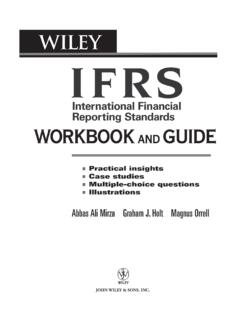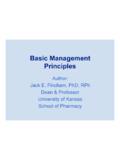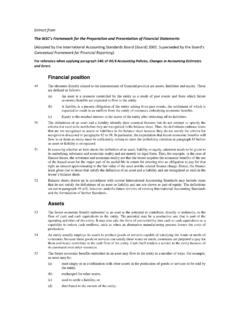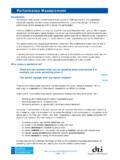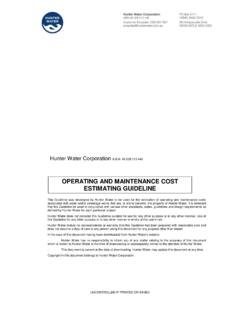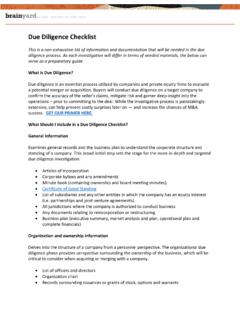Transcription of PwC Guide Derivative instruments and hedging activities
1 2013-2015 PricewaterhouseCoopers LLP, a Delaware limited liability partnership. All rights reserved. PwC refers to the United States member firm, and may sometimes refer to the PwC network. Each member firm is a separate legal entity. Please see for further Derivative instruments and hedging instruments and hedging activities2013 Second edition, July 2015 This publication has been prepared for general information on matters of interest only, and does not constitute professional advice on facts and circumstances specific to any person or entity. You should not act upon the information contained in this publication without obtaining specific professional advice. No representation or warranty (express or implied) is given as to the accuracy or completeness of the information contained in this publication. The information contained in this material was not intended or written to be used, and cannot be used, for purposes of avoiding penalties or sanctions imposed by any government or other regulatory body.
2 PricewaterhouseCoopers LLP, its members, employees and agents shall not be responsible for any loss sustained by any person or entity who relies on this publication. The content of this publication is based on information available as of March 31, 2013. Accordingly, certain aspects of this publication may be superseded as new guidance or interpretations emerge. Financial statement preparers and other users of this publication are therefore cautioned to stay abreast of and carefully evaluate subsequent authoritative and interpretative guidance that is issued. This publication has been updated to reflect new and updated authoritative and interpretative guidance since the 2012 edition. See Appendix B for a Summary of significant changes. Portions of FASB accounting Standards Codification , copyrighted by the Financial accounting Foundation, 401 Merritt 7, Norwalk, CT 06856, are reproduced with permission.
3 PwC Guide library Other titles in the PwC accounting and financial reporting Guide series: Bankruptcies and liquidations (2014) Business combinations and noncontrolling interests, global edition (2014) Consolidations (2015) Fair value measurements, global edition (2015) Financial statement presentation (2014), Second edition Financing transactions: debt, equity and the instruments in between (2014), Second edition Foreign currency (2014) IFRS and US GAAP: similarities and differences (2015) Income taxes (2013), Second edition Revenue from contracts with customers, global edition (2014) Stock-based compensation (2013), Second edition Transfers and servicing of financial assets (2013) Utilities and power companies (2013) Variable interest entities (2013), Second edition To Our Clients and Friends: PricewaterhouseCoopers is pleased to offer this updated comprehensive Guide , which is meant to help you meet the challenges of accounting for Derivative instruments and hedging activities .
4 Domestically and internationally, the volume, variety, and inherent complexity of Derivative transactions have steadily increased and the nature of hedging activities continues to evolve. In practice, hedge accounting is difficult to apply and leads to divergent interpretations. For this reason, the use of Derivative instruments and related hedging activities still attracts heightened scrutiny from regulators and other interested parties. In this Guide we attempt to clarify a complex area of accounting by providing relevant guidance and examples. We also add our own perspective throughout, based on both our analysis of the guidance and our experience in applying it. The FASB continues to amend and provide further clarification of the accounting and disclosure requirements for Derivative and hedging activities to keep pace with the ever evolving nature of Derivative transactions. Additional FASB guidance is sure to come, since practice issues will continue to arise in this area.
5 We will keep you up-to-date on new guidance through further communications whenever it is necessary and useful. Although this publication is intended to clarify the fundamental requirements of accounting for Derivative instruments and to highlight key points that should be considered before transactions are undertaken, it is not a substitute for a thorough analysis of the facts and circumstances surrounding proposed transactions, nor should it be read in place of the relevant accounting literature. Nonetheless, we trust that you will find in these pages information and insights that will allow you to work with greater confidence and certainty when accounting for Derivative instruments and hedging activities . PricewaterhouseCoopers LLP PwC i Table of contents Chapter 1: Executive summary Historical perspective.
6 1-2 Fundamental principles of accounting for derivatives and hedging activities .. 1-2 Challenges associated with accounting for derivatives and hedging activities .. 1-4 Securing resources with the appropriate background and work experience .. 1-4 Preparing hedge documentation .. 1-4 Coordinating between departments .. 1-5 Applying hedge accounting and the shortcut method .. 1-5 Identifying embedded derivatives .. 1-5 How entities have responded .. 1-6 Looking forward: Considerations for accounting for derivatives and hedging activities .. 1-6 A note about this Guide .. 1-8 Chapter 2: Scope Executive takeaway .. 2-2 Definition and scope .. 2-2 Underlying, notional amount and payment provision.
7 2-3 Initial net investment .. 2-5 Net settlement .. 2-6 Net settlement under contract terms .. 2-6 Net settlement through a market mechanism .. 2-8 Net settlement by delivery of Derivative instrument or asset readily convertible to cash .. 2-10 Contracts excluded from ASC 815 s scope .. 2-12 Regular-way security trades .. 2-12 Table of contents ii PwC Normal purchases and normal sales .. 2-13 Qualifying criteria for the normal purchases and normal sales exception .. 2-13 Freestanding option contracts .. 2-17 Forward (non-option-based) contracts .. 2-17 Forward contracts that contain optionality features .. 2-18 Power purchase or sale agreements .. 2-19 Certain insurance contracts .. 2-21 Certain financial guarantee contracts .. 2-22 Certain contracts that are not traded on an exchange.
8 2-23 Derivative instruments that impede sale accounting .. 2-25 Investments in life insurance .. 2-25 Certain investment contracts .. 2-25 Certain loan commitments .. 2-26 Leases .. 2-26 Residual value guarantees .. 2-26 Registration payment arrangements .. 2-27 Certain contracts involving an entity s own equity .. 2-28 Contracts indexed to, and potentially settled in, an entity s own stock .. 2-28 Determining whether a contract is indexed to an entity s own stock .. 2-29 Determining whether a contract is classified in stockholders equity .. 2-31 Share-based payments .. 2-32 Forward contracts to enter into a business combination .. 2-34 Financial instruments within the scope of ASC 480 .. 2-34 Examples of contracts that meet the definition of a Derivative .
9 2-35 Exhibit 2-1 Table of derivatives : Contract types .. 2-35 Table of contents PwC iii Questions and interpretive responses .. 2-40 Question 2-1 Derivative -like instruments .. 2-40 Question 2-2 Forward commitment in a securitization transaction .. 2-40 Question 2-3 Short sales .. 2-41 Question 2-4 Commodity requirements contracts .. 2-41 Question 2-5 Payment provisions .. 2-42 Question 2-6 Payment provisions .. 2-42 Question 2-7 Regular-way securities trades .. 2-43 Question 2-8 Regular-way securities trades .. 2-43 Question 2-9 To-be-announced or when-issued securities trades .. 2-43 Question 2-10 Take-or-pay contracts .. 2-44 Question 2-11 Fair value option .. 2-45 Question 2-12 Option to purchase leased property .. 2-45 Question 2-13 accounting for weather derivatives .. 2-45 Question 2-14 Royalty agreements .. 2-46 Question 2-15 Stock purchase warrants.
10 2-47 Question 2-16 Entities that record financial instruments at fair value .. 2-50 Question 2-17 Continual reassessment of nonderivative contracts .. 2-51 Question 2-18 Continual reassessment of nonderivative contracts .. 2-51 Question 2-19 Continual reassessment of nonderivative contracts .. 2-52 Question 2-20 Impracticability of a fair value estimate .. 2-53 Question 2-21 Repurchase agreements .. 2-53 Question 2-22 Application of ASC 815 to not-for-profit organizations .. 2-54 Table of contents iv PwC Chapter 3: Embedded Derivative instruments Executive takeaway .. 3-2 Hybrid instruments , host contracts, and embedded derivatives .. 3-4 Exhibit 3-1 Types of embedded features added to host contracts .. 3-5 Identifying an embedded Derivative .. 3-5 Determining embedded vs. freestanding .. 3-6 Defining the host contract.




